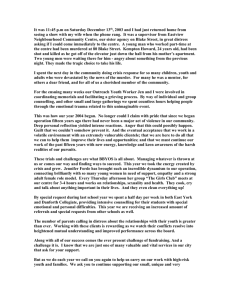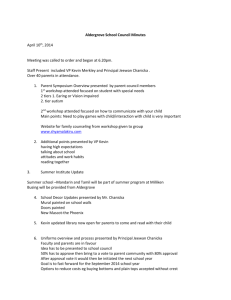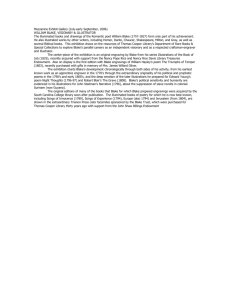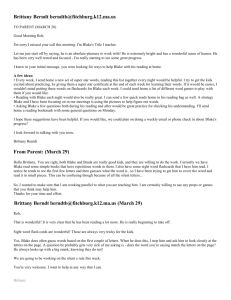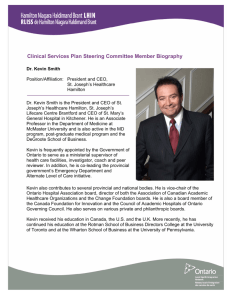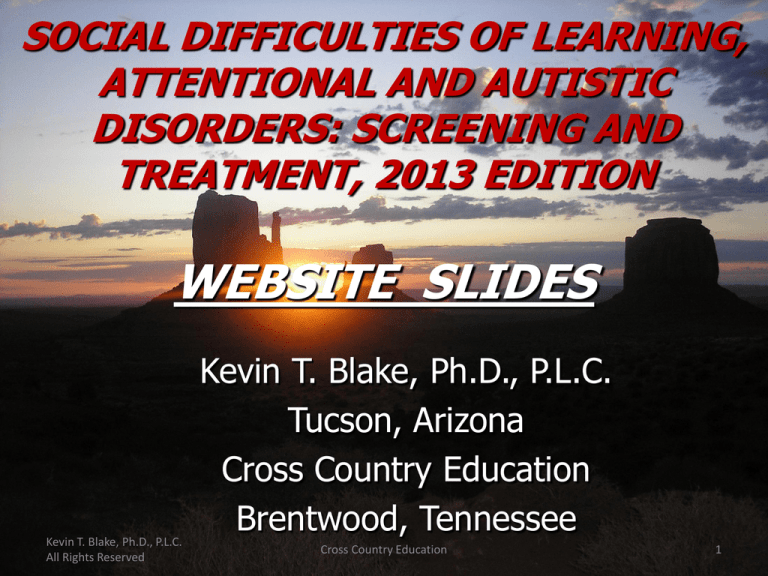
SOCIAL DIFFICULTIES OF LEARNING,
ATTENTIONAL AND AUTISTIC
DISORDERS: SCREENING AND
TREATMENT, 2013 EDITION
WEBSITE SLIDES
Kevin T. Blake, Ph.D., P.L.C.
All Rights Reserved
Kevin T. Blake, Ph.D., P.L.C.
Tucson, Arizona
Cross Country Education
Brentwood, Tennessee
Cross Country Education
1
International Classifications of Diseases11th Edition (ICD-11)
(WEBSITE-1)
• Due to be published in 2015
• Is coordinating diagnostic terms with DSM-5.
• American Psychological Association (APA) is very involved
with development of ICD-11 and the Functional Mental and
Medical Health Companion to ICD-11.
• Psychologists will be strongly encouraged to use the ICD-11
by APA.
Clay, R. A. (July 2010). Defining disease worldwide.: The 11th revision of the International
Classification of Diseases includes psychologists in key roles. Monitor On Psychology, 41 (7), 54.
Goodheart, C. (October 16, 2010). Psychology Practice: Preparing for Tomorrow. Paper Presented at
the 2010 Annual Arizona Psychological Association Convention, Tucson, AZ.
Author (2012). The International Classification of Diseases 11th Revision is due by 2015 . Geneva,
Switzerland: World Health Organization. From website:
http://www.who.int/classifications/icd/revision/en/.
Kevin T. Blake, Ph.D., P.L.C.
All Rights Reserved
Cross Country Education
2
AD/HD Genes (WEBSITE-2)
•
•
•
•
•
•
•
DRD4 – 7 + Repeat
DAT1 – 480 bp
DBH – Taql (A2 allele)
DRD2
SNAP25
MAO-A
13 other possible genes
Barkley, R.A. (2008). ADHD: Advances in, Nature, Diagnosis, and Etiology. Handout for seminar:
Advances in ADHD: Theory, Diagnosis and Management. J & K Seminars, L.L.C., 1861 Wichersham
Lane, Lancaster, PA 17603; 800-801-5415; www.jkseminars.com, p. 9 (Handout).
Kevin T. Blake, Ph.D., P.L.C.
All Rights Reserved
Cross Country Education
3
Genetics and Dyslexia (WEBSITE-3)
• Colorado Learning Disabilities Research
Center:
– Heritability linkage for dyslexia- Chromosomes 2,
3, 6, 15, 18
Olsen, R.K. (November 11, 2005). Norman Geshwin Lecture-Genes, environment and dyslexia.
Paper presented at the 53rd Annual International Dyslexia Association Conference, Denver,
CO.
Kevin T. Blake, Ph.D., P.L.C.
All Rights Reserved
Cross Country Education
4
“Dr. Andrew Wakefield struck off medical register”
(WEBSITE-4)
“Andrew Wakefield, the doctor who triggered the MMR
vaccine scare has been struck off the medical register…Dr.
Wakefield has been found guilty of serious professional
misconduct over “unethical” research that sparked
unfounded fears that the vaccine was linked to bowel
disease and autism…The panel is profoundly concerned that
Dr. Wakefield repeatedly breached fundamental principles of
research medicine…Immunization rates fell, leading to a
resurgence of potentially deadly measles cases in recent
years. The Lancet, which had withdrawn contested parts of
the paper in 2004, subsequently retracted in full”.
Sanchez, R. and Rose, D. (May 25, 2010). Dr. Andrew Wakefield struck off medical register.
Timesonline, www.timesonline.co.uk/to/news/uk/article7134893.ece.
Kevin T. Blake, Ph.D., P.L.C.
All Rights Reserved
Cross Country Education
5
Genes & ASD (WEBSITE-5)
•
•
•
•
•
•
•
Fragile X Syndrome (5 to 15%)
NLGN3
NLGN4X
SHANK3
NRXN1
5p14.1
16p11.2, Etc.
Pinto, D., et al. (June 9, 2010). Functional impact of global rare copy number
variations in autism spectrum disorders. Nature,
www.nature.com/nature/journal/vaop/ncurrent/full/nature09146.html.
Kevin T. Blake, Ph.D., P.L.C.
All Rights Reserved
Cross Country Education
6
Possible Medication for Fragile X
(WEBSITE-6)
Drug manufacturer Novartis stated it is
developing a medication called AFQ056
which initial research demonstrated to have
been very promising in treating Fragile X
Syndrome. It may be that this medication
help synapses reduce background noise.
Harris, G. (April 29, 2010). Promise Seen in Drug for Retardation Syndrome. New York
Times: www.nytimes.com/2010/04/30/health/research/30fragile.html.
Author (May 13, 2010). Efficacy, Safety and Tolerability of AFQ056 in Fragile X
Patients: www.clinicaltrials.gov/ct/show/NCT00718341.
Kevin T. Blake, Ph.D., P.L.C.
All Rights Reserved
Cross Country Education
7
Americans with Disabilities Act,
Amendment Act of 2008
(WEBSITE: 7)
The new act makes it easier for a person to establish they
have a disability. It directed the U.S. Equal Opportunity
Employment Commission to redefine the term “substantially
limits.” The list of “major life activities” was expanded to
include reading, bending, walking, communicating, etc. The
bill included bodily functions like difficulties with the
immune system, bowel functions, etc. People with “episodic
disabilities” are now better protected.
Equal Opportunity Employment Commission:
www.eeoc.gov/laws/statutes/adaaa_notice.cfm.
Kevin T. Blake, Ph.D., P.L.C.
All Rights Reserved
Cross Country Education
8
Americans with Disabilities Act,
Amendments Act of 2008
(WEBSITE: 8)
• Congress made it easier for a person to seek
protection under the ADA if they have a
disability because the term disability is now
interpreted more broadly.
• The term “substantially limits” now requires
a lower degree of functional limitations than
has been applied in the courts.
• “Substantially limits” is now to be considered
more broadly.
Kevin T. Blake, Ph.D., P.L.C.
All Rights Reserved
Cross Country Education
9
Americans with Disabilities Act,
Amendments Act of 2008 (WEBSITE:9)
• One still needs an “individualized assessment”
to determine an impairment in a major life
activity.
• “Mitigating measures” like medication for ADHD
no longer can be used to determine level of
impairment (glasses and contacts excluded).
• An impairment that is episodic or in remission is
still considered a disability.
• Determination of disability should not require
extensive analysis.
Kevin T. Blake, Ph.D., P.L.C.
All Rights Reserved
Cross Country Education
10
Americans with Disabilities Act,
Amendments Act of 2008 (WEBSITE: 10)
• Reading, standing, communicating, bowel
movements, autoimmune functions, etc. are
now considered “major life activities”.
From:
Fact Sheet on the EEOC’s Final Regulations
Implementing the ADAAA:
www1.eeoc.gov//laws/regulations/adaaa_fa
ct_sheet.cfm?renderforprint=1
Kevin T. Blake, Ph.D., P.L.C.
All Rights Reserved
Cross Country Education
11
National Disability Rights Network
(WEBSITE: 11)
National Disability Rights Network
900 Second Street, NE, Suite 211
Washington, DC 2002
P: 202-408-9514
F: 202-408-9520
TTY: 202-408-9521
Website: www.ndrm.org
Kevin T. Blake, Ph.D., P.L.C.
All Rights Reserved
Cross Country Education
12
Section 504
(WEBSITE: 12)
• Section 504 of the Rehabilitation Act of 1973:
– http://www2.ed.gov/policy/speced/reg/narrati
ve.html
– http://www.dol.gov/oasam/regs/statutes/sec5
04.htm
Kevin T. Blake, Ph.D., P.L.C.
All Rights Reserved
Cross Country Education
13
IDEA-2004
(WEBSITE: 13)
• Individuals with Disabilities Education Act of
2004 (IDEA-2004):
http://idea.ed.gov/explore/view/p/%2Croot%2Cr
egs%2C
• The Individuals with Disabilities Education Act:
Provisions Related to Children With Disabilities
Enrolled by Their Parents in Private Schools:
http://www2.ed.gov/admins/lead/speced/private
schools/index.html
Kevin T. Blake, Ph.D., P.L.C.
All Rights Reserved
Cross Country Education
14
School-To-Work Opportunities Act 0f
1994
(WEBSITE: 14)
• All students are to have an official transition
plan to transition to the world of work/postsecondary education.
www.dol.gov/elaws/esa/flsa/scope/ee15astw.
asp
Kevin T. Blake, Ph.D., P.L.C.
All Rights Reserved
Cross Country Education
15
Protecting Students with Disabilities
(WEBSITE: 15)
• Department of Health and Human Services,
Office of Civil Rights (OCR):
• Flyer: Protecting Students with Disabilities;
http://www2.ed.gov/about/offices/list/ocr/
504faq.html
• Office of Civil Rights:
http://www.hhs.gov/ocr/
Kevin T. Blake, Ph.D., P.L.C.
All Rights Reserved
Cross Country Education
16
Ostracism and the Brain
(WEBSITE: 16)
All people, no matter what their psychological makeup
feel the pain of rejection equally.
Within minutes ostracized people experience
significantly lower self-esteem, a lack of meaning in
their life, a lack of control, sadness and anger.
People can feel rejected even by people they do not
know, or even hate.
Being rejected can lead to physical and psychological
illness.
Williams, K.D. (January/February, 2011). The Pain of Exclusion. Scientific American Mind,
21 (6), 30-37.
Kevin T. Blake, Ph.D., P.L.C.
All Rights Reserved
Cross Country Education
17
Ostracism and the Brain
(WEBSITE: 17)
“Even in a verbal or physical altercation, individuals
are still connected. Total exclusion, however, severs
all bonds. Social rejection also deals a uniquely harsh
blow to self-esteem, because it implies wrongdoing”.
(p. 34)
“After all, social exclusion interferes not only with
reproductive success, but also with survival”. (p. 34)
Williams, K.D. (January/February, 2011). The Pain of Exclusion. Scientific American Mind, 21 (6), 30-37.
Kevin T. Blake, Ph.D., P.L.C.
All Rights Reserved
Cross Country Education
18
Ostracism and the Brain
(WEBSITE: 18)
In an MRI study,…”As soon as students began to
feel ostracized, the scanners registered a flurry
of activity in the dorsal anterior cingulate cortex
– a brain region associated with the emotional
aspects of physical pain”. (p. 34)
Also the insula activates and judges the severity
of the pain.
Williams, K.D. (January/February, 2011). The Pain of Exclusion. Scientific American Mind,
21 (6), 30-37.
Kevin T. Blake, Ph.D., P.L.C.
All Rights Reserved
Cross Country Education
19
Ostracism and the Brain
(WEBSITE: 19)
“…social rejection and physical injury are not much
different experiences and share underlying neural
pathways”. (p. 35)
MRI studies have shown that painkillers can reduce the
pain of social rejection.
To reduce the pain of social rejection people will agree,
mimic, obey, or cooperate with the rejecting group.
Even if it goes against their beliefs and/or judgment.
Williams, K.D. (January/February, 2011). The Pain of Exclusion. Scientific American
Mind, 21 (6), 30-37.
Kevin T. Blake, Ph.D., P.L.C.
All Rights Reserved
Cross Country Education
20
Ostracism and the Brain
(WEBSITE: 20)
Depressed and/or socially anxious people
take longer to recover from ostracism than
others.
“In extreme cases, ostracized humans may
resort to aggressive or violent acts when they
have lost hope of being included in any
socially acceptable group”. (p. 36)
Williams, K.D. (January/February, 2011). The Pain of Exclusion. Scientific American
Mind, 21 (6), 30-37.
Kevin T. Blake, Ph.D., P.L.C.
All Rights Reserved
Cross Country Education
21
Ostracism and the Brain
(WEBSITE: 21)
What to do if you are ostracized:
1. Remove yourself from the situation and distract
yourself.
2. Remind yourself of your strengths.
3. Exercise more control in your life; assert
yourself.
4. Reconnect with family and friends.
Williams, K.D. (January/February, 2011). The Pain of Exclusion. Scientific
American Mind, 21 (6), 30-37.
Kevin T. Blake, Ph.D., P.L.C.
All Rights Reserved
Cross Country Education
22
Psychosocial Impairment Scale
(WEBSITE: 22)
Barkley, R.A. (2011). Barkley Functional
Impairment Scale: Rating Scale, Norms,
Interpretive Guide. New York, NY: Guilford.
Kevin T. Blake, Ph.D., P.L.C.
All Rights Reserved
Cross Country Education
23
Employment & AD/HD
(WEBSITE: 23)
• AD/HD workers have significantly lower salaries.
• They are absent from the job more and are
significantly more underproductive than nonAD/HD workers.
• They have more on the job accidents.
• On average AD/HD costs the household $10,000
per year of income.
Ramsay, R. J. (2010). Non-Medication Treatments for Adult ADHD. Washington, DC:
American Psychological Association, p. 79.
Kevin T. Blake, Ph.D., P.L.C.
All Rights Reserved
Cross Country Education
24
AD/HD & DSM-5 (WEBSITE: 24)
In DSM-5 there will be one type of AttentionDeficit/Hyperactivity Disorder and it will be
Attention-Deficit/Hyperactivity Disorder,
Combined Type. What has been learned since
1994 when the DSM-IV was published
through longitudinal studies is that what was
called Attention-Deficit/Hyperactivity
Disorder, Hyperactive/Impulsive Type is the
early manifestation of the Combined Type
of…
Kevin T. Blake, Ph.D., P.L.C.
All Rights Reserved
Cross Country Education
25
AD/HD & DSM-5 (WEBSITE: 25)
…AD/HD in preschool and early grade school.
As the child ages and his/her frontal lobe
develops they gain more and more control of
their hyperactive motor movements and start
to appear like what was called (in DSM-IV
and DSM-IV, TR) “Combined Type”. This
process continues until their late 20s/early
30s when their frontal lobes are fully
developed. By that time they appear to be
“Inattentive Type”…
Kevin T. Blake, Ph.D., P.L.C.
All Rights Reserved
Cross Country Education
26
AD/HD & DSM-5 (WEBSITE: 26)
…When their current adult behavior is
compared to their preschool behavior.
Remember, when you diagnose some one
with AD/HD, you compare them to their nonAD/HD age peers.
Swanson, J., Hinshaw, S., Hechtman, L. and Barkely, R. (November 9, 2012). Research
Symposium 1: Montreal Study; Milwaukee Study; Berkeley Girls ADHD
Longitudinal Study (BGALS). Symposium presented at the 24th Annual CHADD
International Conference, November 8-10, 2012, Burlingame, CA.
Kevin T. Blake, Ph.D., P.L.C.
All Rights Reserved
Cross Country Education
27
AD/HD & DSM-5 (WEBSITE: 27)
Tzelepis stated she has only seen Combined Type
adults in her work and doubts the Predominately
Hyperactive-Impulsive Type exists in adults.
Tzelepis, A. and Mapou, R. (1997, May). Assessment. Paper presented at the PreConference Professional ADD Institute of the 3rd Annual National ADDA Adult ADD
Conference, St. Louis, MO.
Barkley, Murphy and Fischer make similar
observations.
Barkley, R.A., Murphy, K.R., & Fischer, M. (2008). ADHD in Adults: What The Science
Says. New York, NY: Guilford,
p. 37-38.
Kevin T. Blake, Ph.D., P.L.C.
All Rights Reserved
Cross Country Education
28
AD/HD & DSM-5
(WEBSITE: 28)
Brown called those who met DSM criteria for
Hyperactive-Impulsive Type or Combined Type in
Childhood, but only met criteria for Inattentive Type
in Adulthood, ‘CROSSOVERS’.
Brown, T.E. (1995). Differential Diagnosis of ADD Versus ADHD in Adults. In K.G.
Nadeau (Ed.), A Comprehensive Guide to Attention-Deficit Disorder in Adults.
New York: Bruner/Mazel, pp. 93-108.
Kevin T. Blake, Ph.D., P.L.C.
All Rights Reserved
Cross Country Education
29
Longitudinal Studies of AD/HD (WEBSITE: 29)
90
80
70
60
Hyperactivity
Inattentiveness
Non-AD/HD
50
40
30
20
10
0
5 yrs
10 yrs 15 yrs 20 yrs 25 yrs
Barkley, R.A., Murphy, K.R., & Fischer, M. (2008). ADHD in Adults: What The Science
Says. New York, NY: Guilford.
Weiss, G., & Hechtman, L. (1993). Hyperactive Children Grown Up. New York, NY:
Guilford.
Kevin T. Blake, Ph.D., P.L.C.
All Rights Reserved
Cross Country Education
30
AD/HD & DSM-5 (WEBSITE: 30)
Barkley wrote when the Combined Type changes to
the Inattentive Type by adolescence or adulthood
then the person should be thought of as having the
Combined Type.
Barkley, R.A. (2002). ADHD and Oppositional Defiant Children. Seminar
presented, February 19-20, Phoenix, AZ., The Institute for Continuing
Education, Fairhope, AL.
Barkley, R.A. (2006). Attention-Deficit Hyperactivity Disorder, Third Edition. New
York, NY: Guilford.
Barkley, R.A., Murphy, K.R., & Fischer, M. (2008). ADHD in Adults: What
The Science Says. New York, NY: Guilford, p. 37-38.
Kevin T. Blake, Ph.D., P.L.C.
All Rights Reserved
Cross Country Education
31
Inattentive AD/HD? (WEBSITE: 31)
What about Attention-Deficit/Hyperactivity
Disorder, Inattentive Type? It is a separate
and distinct disorder behaviorally, neurobiologically and genetically from AD/HD. It
will not be included in the DSM-5. In research
it may be referred to as AD/HD, Inattentive
(Restrictive) Presentation, Sluggish Cognitive
Tempo and/or Crichton Syndrome.
Barkley, R. A. (November 9, 2012). The Other Attention Disorder: Sluggish
Cognitive Tempo (ADD/SCT) Vs. ADHD– Impairment and Management.
Paper presented at the 24th Annual CHADD International Conference on
ADHD, Burlingame, CA, November 8 – 10, 2012.
Kevin T. Blake, Ph.D., P.L.C.
All Rights Reserved
Cross Country Education
32
DSM-5 & ASD (WEBSITE: 32)
“Because autism is defined by a common set of behaviors,
it is best represented as a single diagnostic category that is
adapted to the individual’s clinical presentation by
inclusion of clinical specifiers (e.g., severity, verbal
abilities and others) and associated features (e.g., known
genetic disorders, epilepsy, intellectual disability and
others.) A single spectrum disorder is a better reflection of
the state of knowledge about pathology and clinical
presentation; previously, the criteria were equivalent to
trying to “cleave meatloaf at the joints”.
Author (2012). Autism Spectrum Disorder: DSM-5 Development. Washington, DC: American Psychiatric
Association: http://www.dsm5.org/ProposedRevision/Pages/proposedrevision.aspx?rid=94#
Kevin T. Blake, Ph.D., P.L.C.
All Rights Reserved
Cross Country Education
33
DSM-5 & ASD (WEBSITE: 33)
• The current three domains of impairment will
become two:
– 1)
– 2)
Social/communication deficits
Fixated interests and repetitive behaviors
Kevin T. Blake, Ph.D., P.L.C.
All Rights Reserved
Cross Country Education
34
DSM-5 Severity of ASD (WEBSITE: 34)
• Level 3 (Requiring Very Substantial Support): Very
limited initiation and minimal response to others.
Extremely difficult to refocus from fixed interests.
• Level 2 (Requiring Substantial Support): Limited
initiation and limited response to others. Difficult to
redirect from fixed Interests.
• Level 1 (Requiring Support): Without support has
difficulty initiating and atypical response to others.
Will resist efforts to redirect from special interests.
Author (January 26, 2011). Autism Spectrum Disorder, Severity. Washington, DC: American
Psychiatric Association:
http://www.dsm5.org/ProposedRevisions/Pages/proposedrevision.aspx?rid=94#.
Kevin T. Blake, Ph.D., P.L.C.
All Rights Reserved
Cross Country Education
35
DSM-5 and Learning Disorders
From May 2010 to May 2012
(WEBSITE: 35)
Types of Learning Disorders:
1.Dyslexia
2.Dyscalculia
3.Learning Disorder, Not Otherwise Specified
Author (2010). Reading Disorder. Washington, DC: American Psychiatric Association;
www.dsm5.org/ProposedRevisions/Pages/proposedrevision.aspx?rid=84#.
Author (2010). Mathematics Disorder. Washington, DC: American Psychiatric Association;
www.dsm5.org/ProposedRevisions/Pages/proposedrevision.aspx?rid=85#.
Kevin T. Blake, Ph.D., P.L.C.
All Rights Reserved
Cross Country Education
36
DSM-5 & Learning Disorders (WEBSITE: 36)
May 2012 to December 2012
• As of May 1, 2012 “Dyslexia” was going to replace
“Reading Disorder”. Afterward the government and
insurance companies warned the committee about
raising the prevalence of disorders. The NICHD
research indicated Dyslexia’s prevalence was about
15%, DSM-IV,TR’s Reading Disorder’s prevalence was
estimated at 4%. After being consulted by Larry Silver,
M.D. the committee decided to drop Dyslexia and
Dyscalculia from DSM-5 and use Silver’s paradigm of
Specific Learning Disorder (Reading), (Writing) and
(Math) to insure lower prevalence rates and to match
what most public schools in the USA call such
disorders.
Kevin T. Blake, Ph.D., P.L.C.
All Rights Reserved
Cross Country Education
37
DSM-5 & Learning Disorders (WEBSITE: 37)
May 2012 to December 2012
Author (2010). Reading Disorder. Washington, DC: American Psychiatric
Association;
www.dsm5.org/ProposedRevisions/Pages/proposedrevision.aspx?rid=84#.
Author (2010). Mathematics Disorder. Washington, DC: American Psychiatric
Association;
www.dsm5.org/ProposedRevisions/Pages/proposedrevision.aspx?rid=85#.
Author (July, 2012). An Insightful Q&A with Dr. Larry Silver: An Inside Look At
DSM-5. Pittsburg, PA: Learning Disabilities Association of America. From
Website: http://www.ldanatl.org/legislative/pubs/120820_DSM-5_QA_with-Larry-Silver.pdf.
Barkley, R. A. (November 9, 2012). The Other Attention Disorder: Sluggish
Cognitive Tempo (ADD/SCT) Vs. ADHD– Impairment and Management. Paper
presented at the 24th Annual CHADD International Conference on ADHD,
Burlingame, CA, November 8 – 10, 2012.
Kevin T. Blake, Ph.D., P.L.C.
All Rights Reserved
Cross Country Education
38
DSM-5 & Learning Disorders (WEBSITE: 38)
May 2012 to December 2012
The International Dyslexia Association sent
12,000 plus petitions explaining the need to
leave dyslexia in the DSM-5.
The Yale Center for Dyslexia and Creativity
sent in 8629 petitions in support of including
dyslexia.
Author (No Date). IDA Position Statement on DSM-5. From website:
http://www.interdys.org/IDAPositionDSM5.htm.
Burgess, T. (December 1, 2012). Dyslexia is Out of DSM-5: Psychiatrists Voted
Saturday, December 1, 2012. Examiner.com. From website:
http://www.examiner.com/article/dyslexia-is-out-of-dsm-5-psychiatristsvoted-saturday-dec-1-2012.
Kevin T. Blake, Ph.D., P.L.C.
All Rights Reserved
Cross Country Education
39
DSM-5 & Learning Disorders (WEBSITE: 39)
May 2012 to December 2012
At the last minute Sally Shaywitz, M.D. and
Bennett, Shaywitz, M.D. of Yale, Ruth Colker,
J.D. of Ohio State University Law School and
Jo Anne Simon, J.D. of Yale Law School
submitted the following document to the
DSM-5 Committee. (See next slide)
Kevin T. Blake, Ph.D., P.L.C.
All Rights Reserved
Cross Country Education
40
DSM-5 & Learning Disorders (WEBSITE: 40)
May 2012 to December 2012
Comments on Proposed DSM-5 Criteria for Specific Learning Disorder from a Legal and
Medical/Scientific Perspective
Professor Ruth Colker, J.D.
Distinguished University Professor
Heck-Faust Memorial Chair in Constitutional Law
The Ohio State University
Moritz College of Law
Professor Sally Shaywitz, M.D.
The Audrey G. Ratner Professor in Learning Development
Co-Director, Yale Center for Dyslexia & Creativity
Yale University School of Medicine
Professor Bennett Shaywitz, M.D.
The Charles and Helen Schwab Professor in Dyslexia and Learning Development
Co-Director, Yale Center for Dyslexia & Creativity
Yale University School of Medicine
Jo Anne Simon, J.D.
Attorney and Adjunct Associate Professor, Fordham University School of Law
Lead Counsel, Bartlett v. New York State Board of Law Examiners
From website:
http://dyslexia.yale.edu/CommentsDSM5ColkerShaywitzSimon.pdf.
Kevin T. Blake, Ph.D., P.L.C.
All Rights Reserved
Cross Country Education
41
DSM-5 & Learning Disorders (WEBSITE: 41)
May 2012 to December 2012 (“The Next Day”)
“DSM- 5 Update from Lee Grossman, IDA Interim Executive
Director and CEO
IDA is closely monitoring the American Psychiatric Association's
(APA) proposed revision to its' Diagnostic and Statistical Manual
of Mental Disorders diagnostic criteria. We are pleased to share
that it appears that the DSM-5 Committee will have the term
dyslexia within the list of specific learning disorders.
We appreciate the Committee's work and thank them for listening
to the concerns of our constituents and the LD community. We
will continue to monitor this and will pass on updates from the
DSM-5 Committee's decisions as those are available”.
Grossman, l. (December 3, 2012). DSM-5 Update. IDA In an Instant.
Baltimore, MD: International Dyslexia Association.
Kevin T. Blake, Ph.D., P.L.C.
All Rights Reserved
Cross Country Education
42
DSM-5 & “Specific Learning Disorder” as
of December 5, 2012 (WEBSITE: 42)
Specific Learning Disorder
Dyslexia/Specific Reading Disorder
Oral Language
Mathematics
Written Language
Author (July, 2012). An Insightful Q&A with Dr. Larry Silver: An Inside Look At DSM-5. Pittsburg, PA: Learning Disabilities
Association of America. From Website: http://www.ldanatl.org/legislative/pubs/120820_DSM-5_Q-A_with-LarrySilver.pdf.
Grossman, l. (December 3, 2012). DSM-5 Update. IDA In an Instant. Baltimore, MD: International Dyslexia Association.
Colker, R., Shaywitz, S., Shaywitz, B., Simon, J.A., (No Date) Comments on Proposed DSM-5 Criteria for Specific Learning
Disorder from a Legal and Medical/Scientific Perspective. Yale Center for Dyslexia and Creativity. From Website:
http://dyslexia.yale.edu/CommentsDSM5ColkerShaywitzSimon.pdf.
Grohol, J.M. (December 5, 2012). Final DSM Approved by American Psychiatric Association. World of Psychology: PsychCentral
From website: http://psychcentral.com/blog/archives/2012/12/02/final-dsm-5-approved-by-american-psychiatricassociation/.
Kevin T. Blake, Ph.D., P.L.C.
All Rights Reserved
Cross Country Education
43
DSM-5 & Nonverbal LD? (WEBSITE: 43)
“Social Communication Disorder (SCD) is an impairment
of pragmatics and is diagnosed based on difficulty in
the social uses of verbal and nonverbal communication
in naturalistic contexts, which affects the development
of social relationships and discourse comprehension
and cannot be explained by low abilities in the domains
of word structure and grammar or general cognitive
ability”.
Rule out ASD, “restricted, repetitive patterns of
behavior, interests or activities as part of the autism
spectrum”.
Author (December 9, 2010). Social Communication Disorder. Washington, DC: American
Psychiatric Association:
http://www.dsm5.org/ProposedRevision/Pages/proposedrevision.aspx?rid=489#.
Author (July, 2011). Recent Updates to Proposed Revisions for DSM-5. Washington, DC:
American Psychiatric Association: http://www.dsm5.org/Pages/RecentUpdates.aspx.
Kevin T. Blake, Ph.D., P.L.C.
All Rights Reserved
Cross Country Education
44
DSM-5 & Nonverbal LD
(WEBSITE: 44)
Rosemary Tannock, Ph.D. who was on the DSM-5 development
committee and responsible for communication disorders said the
DSM-5 would have the following:
Speech Disorder
Language Disorder
Pragmatic Communication Disorder
Communication Disorder
No mention of Social Communication Disorder was mentioned.
Tannock, R. (November 9, 2012). Understanding Speech & Language Problems in ADHD. Paper presented at the 24 th
Annual CHADD International Conference, November 8-10, 2012, Burlingame, CA.
Kevin T. Blake, Ph.D., P.L.C.
All Rights Reserved
Cross Country Education
45
Williams Syndrome
(WEBSITE: 45)
“Williams Syndrome is a genetic condition that is
present at birth and can affect anyone. It is
characterized by medical problems, including
cardiovascular disease, developmental delays and
learning disabilities. These occur side by side with
striking verbal abilities, highly social personalities and
an affinity for music… Individuals with Williams
Syndrome have very endearing personalities. They
have a unique strength in their expressive language
skills and are extremely polite. They are typically
unafraid of strangers and show a greater interest in
contact with adults than with their peers”.
Author (No Date). What Is Williams Syndrome? From Williams Syndrome Association website:
http://www.williams-syndrome.org/what-is-williams-syndrome.
Kevin T. Blake, Ph.D., P.L.C.
All Rights Reserved
Cross Country Education
46
Williams Syndrome
(WEBSITE: 46)
Williams Syndrome is a rare condition caused by missing
genes. Parents may not have any family history of the
condition. However, a person with Williams syndrome has a
50% chance of passing the disorder on to each of his or her
children.
Williams Syndrome occurs in about 1 in 8,000 births.
One of the 25 missing genes is the gene that produces
elastin, a protein that allows blood vessels and other tissues
in the body to stretch. It is likely that having only one copy of
this gene results in the narrowing of blood vessels seen in
this condition.
A.D.A.M. Medical Encyclopedia (November 14, 2011). Williams Syndrome (WilliamsBeuren Syndrome). Bethesda, MD: National Center for Biotechnology
Information, U.S. National Library of Medicine. From website:
http://www.ncbi.nlm.nih.gov/pubmedhealth/PMH0002105/.
Kevin T. Blake, Ph.D., P.L.C.
All Rights Reserved
Cross Country Education
47
Williams Syndrome
(WEBSITE: 47)
Those with Williams Syndrome have brains that are
20% smaller, particularly in the back of the brain
which includes the occipital and parietal lobes. The
temporal lobes are either normal in size or larger than
normal. Their planum temporale is larger than normal
and hence they often have perfect pitch. Finally, they
use their cerebellum, brain stem and amygdala to
process music thus it provides them an uniquely
emotional experience when they hear it.
Sacks, O. (2007). Musicophilia:Tales of Music and the Brain. New York, NY: Alfred A
Knopf.
Kevin T. Blake, Ph.D., P.L.C.
All Rights Reserved
Cross Country Education
48
ASD and Williams Syndrome
(WEBSITE: 48)
ASD and Williams Syndrome, “two sides of
the same coin,” Allan Reiss Stanford Medical
School professor said. Social behavior and
communication are underdeveloped in ASD
and overdeveloped in Williams Syndrome.
Inman, E. (May 20, 2010). New Findings About Williams Syndrome May
Shed Light On Autism Research. The Stanford Daily. From website:
http://www.stanforddaily.com/2010/05/20/new-findings-aboutwilliams-syndrome-may-shine-light-on-autism-research/.
Kevin T. Blake, Ph.D., P.L.C.
All Rights Reserved
Cross Country Education
49
Mirror Neurons (WEBSITE: 49)
• There are visual and audiovisual mirror neurons in the brain
in several places.
• Areas involved in the brain:
– Inferior Frontal Gyrus: guidance of
movement/assessment of intentions
– Anterior Cingulate Cortex: regulation of empathy
– Angular Gyrus: semantic comprehension combining
sensory input
– Insula/Amygdala: pain & disgust
Rizzolatti, G., Fogassi, L. and Gallese, V. (November, 2006). Mirrors in The Mind.
Scientific American, 296 (5), pp. 54-61.
Ramachandran, V.S. and Oberman, L.M. (November, 2006). Broken Mirrors.
Scientific American, 296(5), pp. 62-69.
Kevin T. Blake, Ph.D., P.L.C.
All Rights Reserved
Cross Country Education
50
Psychopathy and
the Brain (WEBSITE: 50)
“Aided by EEGs and brain scans, scientists have
discovered that psychopaths possess significant
impairments that affect their ability to feel
emotions, read other people’s cues and learn from
their mistakes” .(p. 24)
“These deficiencies may be apparent in children
who are as young as five years old”. (p. 24)
Kiehl, K., and Buckholtz, J.W. (September/October, 2010). Inside The Mind of a
Psychopath. Scientific American Mind, 21 (4), 22-29.
Kevin T. Blake, Ph.D., P.L.C.
All Rights Reserved
Cross Country Education
51
Neurology of Psychopathy
(WEBSITE: 51)
“A horseshoe-shaped band of tissue nestled in the deepest
recesses of the brain may be the area that malfunctions in
psychopaths. Known as the paralimbic system, it includes several
interconnected brain regions that register feelings and other
sensations and assign emotional value to experiences. These
brain regions also handle decision making, high level reasoning
and impulse control. People with brain damage in these areas
tend to develop psychopathic traits and behaviors. And imaging
studies reveal that in psychopaths, the paralimbic areas tend to be
underdeveloped”. (p. 27)
Kiehl, K., and Buckholtz, J.W. (September/October, 2010). Inside The Mind of a
Psychopath. Scientific American Mind 21 (4), 22-29.
Kevin T. Blake, Ph.D., P.L.C.
All Rights Reserved
Cross Country Education
52
COGMED and ADHD
(WEBSITE: 52)
“This study evaluated the impact of two
interventions—a training program and stimulant
medication—on working memory (WM)
function in children with attention deficit
hyperactivity disorder (AD/HD). Twenty-five
children aged between 8 and 11 years
participated in training that taxed WM skills to
the limit for a minimum of 20 days, and
completed other assessments of WM and IQ
before and after training, and with and without
prescribed drug treatment. While medication
significantly…”
Kevin T. Blake, Ph.D., P.L.C.
All Rights Reserved
Cross Country Education
53
COGMED and ADHD
(WEBSITE: 53)
“…improved visual-spatial memory performance,
training led to substantial gains in all components of
WM across untrained tasks. Training gains associated
with the central executive persisted over a 6-month
period. IQ scores were unaffected by either
intervention. These findings indicate that the WM
impairments in children with ADHD can be
differentially ameliorated by training and by
stimulant medication”. (p. 827)
Holmes, J., Gathercole, S., Place, M., Dunning, D., Hilyon, K., and Elliot, J. (2010). Working Memory
Deficits Can be Overcome: Impacts of Training and Medication On Working Memory in Children
with ADHD. Applied Cognitive Psychology, 24, 827-836.
Kevin T. Blake, Ph.D., P.L.C.
All Rights Reserved
Cross Country Education
54
COGMED (www.cogmed.com)
(Research-54)
• Problems with research:
– Unclear if positive outcomes connect to
improved life functioning.
– How does it work?
– Maybe one of the first attempts of cognitive
training that has been successful. (Barkley, 2008)
Ramsay, R. (2010). Nonmedication Treatments for Adult ADHD.
Washington, DC: American Psychological Association Press.
Barkley, R.A. (2008). Advances in ADHD: Theory, Diagnosis and
Management. J & K Seminars, L.L.C., 1861 Wichersham Lane,
Lancaster, PA 17603; 800-801-5415; www.jkseminars.com, Disc 7,
Tack 1.
Kevin T. Blake, Ph.D., P.L.C.
All Rights Reserved
Cross Country Education
55
COGMED and AD/HD
(WEBSITE: 55)
Barkely (2012) still remains skeptical about
COGMED, feels other programs (e.g.,
Lumosity, etc.) may be just as useful, it costs,
too much and it may only help the person
improve on working memory tests for a short
period of time.
Barkley, R. A. (November 9, 2012). The Other Attention Disorder: Sluggish Cognitive
Tempo (ADD/SCT) Vs. ADHD– Impairment, and Management. Paper presented at
the 24th Annual CHADD International Conference on ADHD, Burlingame, CA,
November 8 – 10, 2012.
Kevin T. Blake, Ph.D., P.L.C.
All Rights Reserved
Cross Country Education
56
Literature Review of Working Memory Training
(WEBSITE:56)
“The literature review highlights several findings that warrant
further research but ultimately concludes that there is a need to
directly demonstrate that WM capacity increases in response to
training. Specifically, we argue that transfer of training to WM
must be demonstrated using a wider variety of tasks, thus
eliminating the possibility that results can be explained by task
specific learning. Additionally, we express concern that many of
the most promising results (e.g., increased intelligence) cannot be
readily attributed to changes in WM capacity. Thus, a critical goal
for future research is to uncover the mechanisms that lead to
transfer of training”.
Shipstead, Z., Redick, T.S. and Randall, W.E. (2012). Is Working Memory Training
Effective? Psychological Bulletin, DOI: 10.1037/a0027473.
Kevin T. Blake, Ph.D., P.L.C.
All Rights Reserved
Cross Country Education
57
Meta-Analytic Review of Working Memory
Training (WEBSITE: 57)
“…Meta-analyses indicated that the programs
produced reliable short-term improvements
in working memory skills. For verbal working
memory, these near-transfer effects were not
sustained at follow-up, whereas for
visuospatial working memory, limited
evidence suggested that such effects might
be maintained…”
Kevin T. Blake, Ph.D., P.L.C.
All Rights Reserved
Cross Country Education
58
Meta-Analytic Review of Working Memory
Training (WEBSITE: 58)
“…More importantly, there was no convincing
evidence of the generalization of working
memory training to other skills (nonverbal and
verbal ability, inhibitory processes in attention,
word decoding and arithmetic). The authors
conclude that memory training programs appear
to produce short-term, specific training effects
that do not generalize….”
Melby-Lervag, M., and Hulme, C. (May 12, 2012). Is Working Memory Training
Effective? A Meta-Analytic Review. Developmental Psychology. From
website: http://www.ncbi.nlm.nih.gov/pubmed/22612437 .
Kevin T. Blake, Ph.D., P.L.C.
All Rights Reserved
Cross Country Education
59
Neurobiofeedback (NF) and AD/HD
(WEBSITE: 59)
Recently two important studies on
neurobiofeedback and AD/HD have been
conducted in Germany.
The first study was a standard randomized
control study. The second one was a 6 month
follow up study of the subjects in the first
study.
There are some concerns about both studies
because the study was not double-blind.
Kevin T. Blake, Ph.D., P.L.C.
All Rights Reserved
Cross Country Education
60
Neurobiofeedback (NF) and AD/HD
(WEBSITE: 59)
The researcher of these studies wrote:
“A reduction of at least 25% in the primary outcome
measure (responder criterion) was observed in 50%
of the children in the NF group. In conclusion,
behavioural improvements induced by NF training
in children with AD/HD were maintained at a 6month follow-up. Though treatment effects appear
to be limited…NF may be recommended as a
treatment module for children with AD/HD besides
conventional behavioural training and medication”.
(p. 715 and 722) (May, 2010 article)
Kevin T. Blake, Ph.D., P.L.C.
All Rights Reserved
Cross Country Education
61
Neurobiofeedback (NF) and ADHD
(WEBSITE: 60)
Gevensleben, H., Holl, B.,Albrecht, B., Vogel, C.,
Schlamp, D., Kratz, O., Studer, P. Rothenberger A.,
Moll, G.H. and Heinrich, H. (July, 2009). Is
Neurobiofeedback an Efficacious Treatment for
ADHD? A Randomized Controlled Clinical Trial.
Journal of Child Psychology and Psychiatry, 50 (7), p.
767-768.
Fisher, C. (February 20, 2009). Children with ADHD
Realize Significant Benefits From Neurofeedback
Training In a Randomized Clinical Trial. The Behavioral
Medicine Report. From website:
www.bmedreport.com/archieves/1037.
Kevin T. Blake, Ph.D., P.L.C.
All Rights Reserved
Cross Country Education
62
Neurobiofeedback (NF) and ADHD
(WEBSITE: 61)
Gevensleben, H., Holl, B.,Albrecht, B., Vogel,
C., Schlamp, D., Kratz, O., Studer, P.
Rothenberger A., Moll, G.H., and Heinrich, H.
(May, 2010). Neurofeedback Training in
Children with ADHD: 6-Month Follow-up of a
Randomized Control Trial. European Child
and Adolescent Psychiatry, 19, 715-724.
Kevin T. Blake, Ph.D., P.L.C.
All Rights Reserved
Cross Country Education
63
Neurobiofeedback and AD/HD
(WEBSITE: 62)
NIMH Pilot Study of Double-Blind Randomized Control
Neurobiofeedback Use with AD/HD:
Conducted at the Nisonger Center at Ohio State University
Gene Arnold and Nicholas Lofthouse, primary investigators
Used Smartbrain Neurobiofeedback Technology
39 AD/HD, 6 to 12 year olds randomly assigned to two groups:
(1) Sham Control and (2) Treatment
Abranwitz, A. , Lofthouse, N., deBeus, R., Hirshberg, L. and Barkley, R. (November 12, 2010). EEG
Neurobiofeedback for ADHD: Review of Science, New Findings. Paper and Symposium presented
at the 22nd Annual CHADD Conference, Atlanta, GA, Session FD10.
Kevin T. Blake, Ph.D., P.L.C.
All Rights Reserved
Cross Country Education
64
Neurobiofeedback and AD/HD
(WEBSITE: 63)
NIMH Neurobiofeedback Pilot Study Results:
Retention rate 24 sessions 92%; 40 sessions 87%
Three treatments per week tolerated best
Twenty-four session optimal number
Abranwitz, A. , Lofthouse, N., deBeus, R., Hirshberg, L., and Barkley, R. (November
12, 2010). EEG Neurobiofeedback for ADHD: Review of Science, New Findings.
Paper and Symposium presented at the 22nd Annual CHADD Conference, Atlanta,
GA, Session FD10.
Kevin T. Blake, Ph.D., P.L.C.
All Rights Reserved
Cross Country Education
65
Neurobiofeedback and AD/HD
(WEBSITE: 64)
NIMH Pilot Study Results (Continued):
No difference between treatment and sham control
groups in parent and teacher ratings for AD/HD,
hyperactive/impulsive symptoms, inattentive
symptoms, oppositional defiant symptoms and
executive function symptoms.
The treatment group saw no change in their thetabeta ratios.
Abranwitz, A. , Lofthouse, N., deBeus, R., Hirshberg, L. and Barkley, R. (November 12, 2010). EEG
Neurobiofeedback for ADHD: Review of Science, New Findings. Paper and Symposium presented
at the 22nd Annual CHADD Conference, Atlanta, GA Session FD10.
Kevin T. Blake, Ph.D., P.L.C.
All Rights Reserved
Cross Country Education
66
Neurobiofeedback and AD/HD
(WEBSITE: 65)
NIMH Pilot Study Results (Continued):
Barkley stated after hearing the above data regarding what
clinicians should say to clients interested in pursuing
neurobiofeedback as a treatment for AD/HD:
“The status of the evidence does not allow a
recommendation to be made (sic. for neurobiofeedback).
The clinician should give the information, but not render a
suggestion. Allow the client to use their own informed
consent.
Abranwitz, A. , Lofthouse, N., deBeus, R., Hirshberg, L., and Barkley, R. (November 12, 2010).
EEG Neurobiofeedback for ADHD: Review of Science, New Findings. Paper and Symposium
presented at the 22nd Annual CHADD Conference, Atlanta, GA, Session FD10.
Kevin T. Blake, Ph.D., P.L.C.
All Rights Reserved
Cross Country Education
67
Recent Review of Neurobiofeedback Research
Results with AD/HD (WEBSITE: 66)
Based on the results and methodologies of
published studies, this review concludes that
NF for pediatric AD/HD can be currently
considered as “probably efficacious”.
Lofthouse, N, Arnold, E., Hersch, S. Hurt, E. and DeBeus, R. (November 16, 2011). A
Review of Neurobiofeedback Treatment for Pediatric ADHD. Journal of Attention
Disorders. doi: 10.1177/1087054711427530 .
Kevin T. Blake, Ph.D., P.L.C.
All Rights Reserved
Cross Country Education
68
Recent Review of Neurobiofeedback Research
Results with AD/HD (WEBSITE: 67)
According to Rabiner (January 2012). The “probably
efficacious” rating of the American Psychological
Association is the third highest rating out of a potential 5
levels research can obtain with 5 being the highest.
“Probably efficacious” means the research in question
has, “Shown to produce positive effects in more than one
clinical, observational wait list or within-subject or
between-subject study”. When writing regarding the
Lofthose study (November 16, 2011). Rabiner stated,
“When averaged across the studies for which appropriate
outcome data was available, the overall mean effect size
(ES) was .79 for inattention measures and .71 for
hyperactivity/impulsivity measures…”
Kevin T. Blake, Ph.D., P.L.C.
All Rights Reserved
Cross Country Education
69
Recent Review of Neurobiofeedback Research
Results with AD/HD (WEBSITE:68)
“…These are in a range that would be considered
'large' for inattention and 'moderate' for
hyperactivity/impulsivity and are below what is
typically reported for stimulant medication. Five of
the studies showed neurophysiological changes that
were specific to neurofeedback treatment. Overall,
these results are consistent with beneficial effects of
neurofeedback treatment for AD/HD”.
Rabiner, D. (January, 2012). New Review of Neurobiofeedback Treatment for
ADHD-State of the Science. Attention Research Update. E-mail
newsletter: attentionresearchupdate@helpforadd.com.
Kevin T. Blake, Ph.D., P.L.C.
All Rights Reserved
Cross Country Education
70
Attention & Mindfulness
(WEBSITE: 69)
A type of mindfulness training based on Chinese medicine
called integrative body-mind training (IBMT) has been
found to increase the activation and self-regulation
functions of the anterior cingulate cortex in 5 days and
significant improvement in alerting within a month. In
addition, after 5 days of training, subjects’ cortisol levels
are lower before beginning tasks and after 30 days of
training their baseline cortisol levels are lower. This has
also been connected to immune system function
improvement. The white matter connectivity between the
attention networks in the brain improved. IBMT has been
used in children as young as 4 and in people 55 and over
and has been shown to be more effective than aerobic
exercise in helping to retain memory and attention.
Kevin T. Blake, Ph.D., P.L.C.
All Rights Reserved
Cross Country Education
71
Attention & Mindfulness
(WEBSITE: 70)
All of the above has been found in double-blind
randomized studies with a control group that
receives relaxation training. The relaxation
training groups have not experienced the same
benefits of their training.
Michael Posner said, “In theory, at least, this
might be applied to children with AD/HD”.
(November 12, 2010, CHADD Conference)
Note: IBMT has not been studied with AD/HD
Kevin T. Blake, Ph.D., P.L.C.
All Rights Reserved
Cross Country Education
72
Attention & Mindfulness
(WEBSITE: 71)
Posner, M.I., Swanson, J. and Fowler, J.
(November 12, 2010). Research Symposium. 22
Annual CHADD International Conference,
Atlanta, GA.
Yi-Yuan, Tang, Qilin, Lu, Xiujuan, Geng, Stein,
E.A., Yihong Yang and Posner, M.I. (August 31,
2010). Short-term Meditation Induces White
Matter Changes in the Anterior Cingulate.
Proceedings of the National Academies of
Sciences of the United States of America, 107
(35), 15649-15652.
Kevin T. Blake, Ph.D., P.L.C.
All Rights Reserved
Cross Country Education
73
Attention & Mindfulness
(WEBSITE: 72)
Yi-Yaun, Tang, et. Al. (October 23, 2007). Shortterm Meditation Training Improves Attention
and Self-regulation. Proceedings of the National
Academy of Sciences of the United States of
America, 104 (43), 17152-17156.
Yi-Yuan Tang, et. al. (June 2, 2009). Central and
Autonomic Nervous System Interaction is
Altered by Short-Term Meditation. Proceedings
of the National Academies of Sciences of the
United States of America, 106 (22), 8865-8870.
Kevin T. Blake, Ph.D., P.L.C.
All Rights Reserved
Cross Country Education
74

